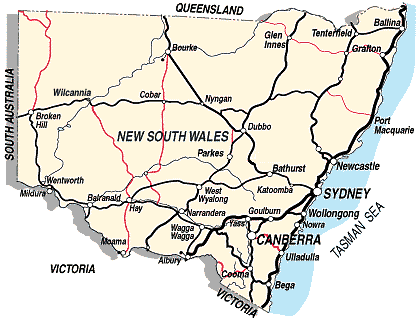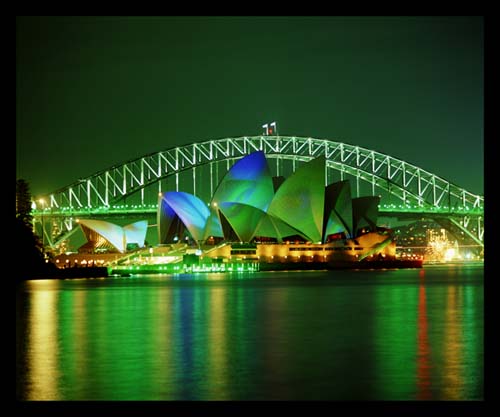![]() Deutschsprachige
Texte sind durch die deutsche Flagge markiert.
Deutschsprachige
Texte sind durch die deutsche Flagge markiert.

 New South Wales
New South WalesAREA: 801,600 sq. km., POPULATION: 5,000,000
CAPITAL: Sydney
(4,000,000 approx.)

New South Wales was the
site of the first settlement in Australia and Sydney Cove
in 1788. In the little over 200 years since this tiny
beginning it has grown into one of the world's greatest
agricultural producing areas with most of the eastern
hinterland growing a variety of crops and the more remote
western areas farming cattle and sheep.
The Great Dividing Range runs the length of the state
parallel to the sea and divides the rich coastal farming
flats from the more arid inland regions.
During early settlement these ranges proved an obstacle
to land hungry settlers and it was not until 1814 that
Blaxland, Wentworth and Lawson found a way over them
using a route which is now roughly followed by the Great
Western Highway through Katoomba and the Blue Mountains.
The Australian Capital Territory lies in the
south-eastern quarter of the state some 300km. south of
Sydney.





click on the map for enlargement (and better quality)
| Sydney | Jan | Feb | Mar | Apr | May | Jun | July | Aug | Sept | Oct | Nov | Dez |
| Temperature max. (C) | 26 | 25 | 25 | 22 | 19 | 17 | 16 | 17 | 20 | 22 | 24 | 25 |
| Temperature min. (C) | 18 | 18 | 17 | 15 | 11 | 9 | 8 | 9 | 11 | 13 | 15 | 17 |
| Rainfall (in mm) | 98 | 113 | 128 | 127 | 124 | 131 | 105 | 81 | 70 | 75 | 78 | 80 |
| Water Temperature (C) | 22 | 22 | 22 | 21 | 19 | 17 | 16 | 16 | 16 | 17 | 19 | 20 |
 Sydney,
die Hauptstadt von New South Wales, ist eine weltoffene,
multikulturelle Metropole mit meist angenehm warmen
Klima. Die absolute Maximaltemperatur wurde mit 45,5 Grad
Celsius gemessen. Die Ausdehnung beträgt knapp 4.100 qkm
und umfasst 490 Vororte und Stadtteile. Sydney wird auch
die heimliche Hauptstadt Australiens genannt. Es besteht
seit langem eine Rivalität mit Melbourne. Sydney war
Austragungsort der Olympischen Sommerspiele des Jahres
2000. Die spektakuläre Lage Sydneys am Port Jackson
und die vielen Strände
sind zwei der Gründe, warum Sydney zu den schönsten
Städten der Welt zählt. Bei einer Hafenrundfahrt lassen
sich die Skyline und einige der Sehenswüdigkeiten
bestaunen. Zentraler Anlegeort für die Fähren und die
meisten Ausflugsboote ist Circular Quay (zwischen Oper
und Harbour Bridge gelegen). Für die Besichtigung
Sydneys sollten mindestens 3-4 Tage eingeplant werden.
Wir empfehlen: die Harbour
Bridge, the Rocks, das Opernhaus, Royal Botanic Gardens,
den Sydney Tower, einen Loop mit der Monorail-Bahn, Queen Victoria
Building, Darling Harbour, das dort
gelegene Sydney Aquarium
und den Taronga Zoo
(am besten mit der Fähre ab Circular Quay zum Zoo
fahren, Tickets inkluisive Zoo-Eintritt sind dort
erhältlich). Der Besuch einiger der vielen Strände ist
ebenfalls empfehlenswert, z.B. in Bondi
oder Manly.
Lohnenswert ist auch ein Tagesausflug (oder mehr) in die Blue Mountains
(ca 100 km westlich von Sydney). Der Name Blue Mountains
beruht auf ätherischen Ölen, die manchmal wie ein
blauer Schimmer über den Eukalyptuswäldern liegen.
Spektakulär sind u.a. die Three
Sisters oder eine Fahrt mit dem Scenic Skyway.
Die Blue Mountains bieten sich auch für Wanderungen an.
Auf dem Weg nach Süden, z.B. nach Melbourne, lohnt es
sich bei gutem Wetter mehr als eine Nacht in Kiama
(südlich von Wollongong) einzuplanen. Der Ort hat
schöne Strände,
einen Leuchtturm
und ein Blowhole.
Sydney,
die Hauptstadt von New South Wales, ist eine weltoffene,
multikulturelle Metropole mit meist angenehm warmen
Klima. Die absolute Maximaltemperatur wurde mit 45,5 Grad
Celsius gemessen. Die Ausdehnung beträgt knapp 4.100 qkm
und umfasst 490 Vororte und Stadtteile. Sydney wird auch
die heimliche Hauptstadt Australiens genannt. Es besteht
seit langem eine Rivalität mit Melbourne. Sydney war
Austragungsort der Olympischen Sommerspiele des Jahres
2000. Die spektakuläre Lage Sydneys am Port Jackson
und die vielen Strände
sind zwei der Gründe, warum Sydney zu den schönsten
Städten der Welt zählt. Bei einer Hafenrundfahrt lassen
sich die Skyline und einige der Sehenswüdigkeiten
bestaunen. Zentraler Anlegeort für die Fähren und die
meisten Ausflugsboote ist Circular Quay (zwischen Oper
und Harbour Bridge gelegen). Für die Besichtigung
Sydneys sollten mindestens 3-4 Tage eingeplant werden.
Wir empfehlen: die Harbour
Bridge, the Rocks, das Opernhaus, Royal Botanic Gardens,
den Sydney Tower, einen Loop mit der Monorail-Bahn, Queen Victoria
Building, Darling Harbour, das dort
gelegene Sydney Aquarium
und den Taronga Zoo
(am besten mit der Fähre ab Circular Quay zum Zoo
fahren, Tickets inkluisive Zoo-Eintritt sind dort
erhältlich). Der Besuch einiger der vielen Strände ist
ebenfalls empfehlenswert, z.B. in Bondi
oder Manly.
Lohnenswert ist auch ein Tagesausflug (oder mehr) in die Blue Mountains
(ca 100 km westlich von Sydney). Der Name Blue Mountains
beruht auf ätherischen Ölen, die manchmal wie ein
blauer Schimmer über den Eukalyptuswäldern liegen.
Spektakulär sind u.a. die Three
Sisters oder eine Fahrt mit dem Scenic Skyway.
Die Blue Mountains bieten sich auch für Wanderungen an.
Auf dem Weg nach Süden, z.B. nach Melbourne, lohnt es
sich bei gutem Wetter mehr als eine Nacht in Kiama
(südlich von Wollongong) einzuplanen. Der Ort hat
schöne Strände,
einen Leuchtturm
und ein Blowhole.